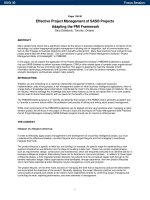Market Orientation: Toward an Integrated Framework pot
Bạn đang xem bản rút gọn của tài liệu. Xem và tải ngay bản đầy đủ của tài liệu tại đây (158.52 KB, 5 trang )
Heiens / Market Orientation
Market Orientation: Toward an Integrated Framework
Richard A. Heiens
University of South Carolina Aiken
Dr. Richard Heiens is Assistant Professor of Marketing at the University of South Carolina Aiken, School of Business Administration,
471 University Parkway, Aiken, SC 29801. (803) 641-3238.
EXECUTIVE SUMMARY
"Market orientation," may actually encompass several different approaches to the strategic alignment of the organization
with the external environment. This article develops a market orientation typology matrix as a pedagogical and heuristic
tool to summarize these distinct approaches. Specifically, firms can decide to focus primarily on either competitors or
customers as the situation dictates, or perhaps attempt the difficult task of simultaneously monitoring both with equal
emphasis. The proposed matrix includes four distinct approaches to market orientation: "customer preoccupied,"
"marketing warriors," "strategically integrated," and "strategically inept".
Firms which emphasize customer-focused intelligence gathering activities at the expense of competitor information may
be classified as "customer preoccupied". Because the marketing concept promotes putting the interests of customers first,
many researchers consider a customer-focus to be the most fundamental aspect of market orientation. Because the
marketing concept encourages a business to be forward looking, a customer-focused business is likely to be more
interested in long-term business success as opposed to short-term profits.
Firms that emphasize competitors in their external market analyses have been labeled "marketing warriors". Using target
rivals as a frame of reference, competitor-focused firms seek to identify their own strengths and weaknesses and to keep
pace with or stay ahead of the rest of the field. Because such competitors may frequently alter their strategic emphasis, a
close monitoring of competitors is difficult yet important in a hostile environment (Porter 1980).
Firms characterized as "strategically integrated" assign equal emphasis to the collection, dissemination, and use of both
customer and competitor intelligence. Many researchers suggest a balance between the two perspectives is most desirable,
and firms should seek to remain sufficiently flexible to shift resources between customer and competitor emphasis as
market conditions change in the short run.
Failure to develop a market orientation, either customer or competitor-focused, may adversely effect business
performance. Consequently, firms that fail to orient their strategic decision making to the market environment may
appropriately be labeled as "strategically inept".
Academy of Marketing Science Review
Volume 2000 No. 1 Available:
Copyright © 2000 – Academy of Marketing Science.
Heiens / Market Orientation 1
Market Orientation: Toward an Integrated Framework
Some of the elements of modern business and marketing practices can perhaps be traced as far back as the ancient Greeks,
the Phoenicians, and the Venetian traders. The earliest recorded identification of the "marketing concept" was put forth in
the 1700s by Adam Smith. In his writings, the famous economist discusses making the customer the focus of a business.
Reintroduced in the modern era in the 1950s, the marketing concept has become the philosophical foundation for
marketing academics and practitioners alike.
Proponents of the marketing concept have long argued that creating a satisfied customer should be the primary objective
of business (Drucker 1954, Keith 1960, Levitt 1960). Throughout the past four decades, however, the marketing concept
has been more an article of faith than a practical basis for managing a business (Day 1994). Consequently, academics in
recent years have begun to develop a body of research on "market orientation", related to the antecedents and performance
consequences of the marketing concept (Deshpande and Webster 1989, Jaworski and Kohli 1993, Narver and Slater
1990). According to Kohli and Jaworski (1990), the marketing concept is a business philosophy, whereas the term market
orientation refers to the actual implementation of the marketing concept.
Consistent with the marketing concept, customers have traditionally been considered to be the primary focus of a market
orientation (Deshpande and Webster 1989, Payne 1988). Other researchers, however, have begun to embrace a broader
perspective on the market orientation construct by including exogenous factors that influence customer needs, such as
competitors and even government regulation (Kohli and Jaworski 1990, Lusch and Lazniak 1987, Slater and Narver
1994a). In addition, the popular business press is replete with works promulgating a competitor orientation in the practice
of strategic marketing, often relying on a warfare analogy (e.g., Ries and Trout 1986). Consequently, despite the academic
emphasis on customer orientation, practitioners may actually be influenced to operate with a strong focus on competitors.
With such disparity in focus, it is evident that the broad term, "market orientation," may actually encompass several
different approaches to the strategic alignment of the organization with the external environment. The unique contribution
of this article is in the development of the market orientation typology matrix as a pedagogical and heuristic tool to
summarize these distinct approaches. Specifically, this conceptualization of the market orientation construct suggests four
distinct strategic types, involving tradeoffs in the allocation of resources to the strategic monitoring of customers and/or
competitors.
THE MARKET ORIENTATION CONSTRUCT
Market orientation is an aspect of organizational culture that is believed to have far-reaching effects on the firm.
According to Deshpande and Webster (1989), the most relevant aspect of organizational culture from a marketing
perspective is the marketing concept, which includes "a fundamental shared set of beliefs and values that puts the
customer in the center of the firm's thinking about strategy and operations" (p. 3).
Although information on the external environment is obviously vital to sound managerial decision-making, the relevant
external environment not only consists of customers, but competitors as well. In fact, Day and Wensley (1988) suggest
that in addition to customer characteristics, the number and power of competitors could strongly effect the focus of the
intelligence gathering activity.
Perhaps Kotler (1977) offered the first significant mention of a competitor focus with respect to the marketing concept.
According to Kotler (1977), an effective marketing organization focuses on the external environment, which is said to
include both customers and competitors. Kohli and Jaworski (1990) echo this point by describing market orientation as
the ability of an organization to generate, disseminate, and use superior information about both customers and
competitors.
Academy of Marketing Science Review
Volume 2000 No. 1 Available:
Copyright © 2000 – Academy of Marketing Science.
Heiens / Market Orientation 2
THE MARKET ORIENTATION MATRIX
Although Slater and Narver (1994a) found no main effect for customer versus competitor-focus on market performance,
they do recognize that "because businesses have limited resources to generate market intelligence, trade-offs between
customer and competitor monitoring must necessarily be made" (Slater and Narver 1994, p.47). Consequently, firms may
frequently emphasize one external variable in their environmental monitoring at the expense of the other, leading to a
specific market orientation profile. By combining these two important external variables, customers and competitors, a
four-cell market orientation matrix emerges as shown in Figure 1.
FIGURE 1
Market Orientation Matrix
Customer Focus
High Low
High
Strategically
Integrated
Marketing
Warriors
Competitor
Focus
Low
Customer
Preoccupied
Strategically
Inept
Customer Preoccupied
Firms emphasizing customer-focused intelligence gathering activities at the expense of competitor information may be
classified as "customer preoccupied." Because the marketing concept promotes putting the interests of customers first,
many researchers consider a customer-focus to be the most fundamental aspect of corporate culture (Deshpande, Farley,
and Webster 1993, Lawton and Parasuraman 1980). According to Slater and Narver (1994a), however, a customer
emphasis is most important when the market is growing and when markets are fragmented and buyer power is low. When
markets are growing, it is important to focus on lead users because they may serve as reference points for later adopters
(Von Hippel 1986). Also, when markets are fragmented and buyer power is low, customer needs are less well understood,
so a customer emphasis should have a greater impact on performance (Slater and Narver 1994a). In addition, Day and
Wensley (1988) suggest that "in dynamic markets with shifting mobility barriers, many competitors, and highly
segmented end-user markets, a customer-focus is mandatory" (p. 17). As such, the first proposition is suggested.
Proposition 1: Increases in customer-focus lead to increases in market share performance in growing markets.
Marketing Warriors
Borrowing from the famous warfare analogy proposed by Ries and Trout (1986), firms with a predominant emphasis on
competitors in their external market analyses have been labeled "marketing warriors." According to Slater and Narver
(1994b), a competitor-focus entails gathering intelligence on three main questions: (1) Who are the competitors? (2) What
technologies do they offer? and (3) Do they represent an attractive alternative from the perspective of the target
customers? Using target rivals as a frame of reference, competitor-focused firms seek to identify their own strengths and
weaknesses and to keep pace with or stay ahead of the rest of the field (Han, Kim, and Srivastava 1998). According to
Day and Wensley (1988), when market demand is predictable, the competitive structure is concentrated and stable, and
there are few powerful customers, the emphasis is necessarily on competitors. Moreover, the lesser the degree of
competitive hostility, the greater the positive impact of competitor emphasis on performance (Slater and Narver 1994a).
Proposition 2: Increases in competitor-focus lead to increases in market share performance in stable and predictable
markets.
Strategically Integrated
Firms characterized as strategically integrated assign equal emphasis to the collection, dissemination, and use of both
customer and competitor intelligence. A focus on both customers and competitors is important because a complete
Academy of Marketing Science Review
Volume 2000 No. 1 Available:
Copyright © 2000 – Academy of Marketing Science.
Heiens / Market Orientation 3
reliance on either customer-focused or competitor-focused decision making can often lead to an incomplete business
strategy, leaving an organization handicapped by a reactive posture (Day and Wensley 1988). According to Day and
Wensley (1988, p. 2), focusing primarily on either customers or competitors could lead to "a partial and biased picture of
reality." In examining the impact of customer versus competitor-focus, Slater and Narver (1994a) found little empirical
support for the effectiveness of different relative emphases within a market orientation. Consequently, Slater and Narver
(1994a) suggest a balance between the two perspectives is most desirable, and firms should seek to remain sufficiently
flexible to shift resources between customer and competitor emphasis as market conditions change in the short run.
However, due to the high cost of monitoring both customers and competitors, these firms may sacrifice ROI for market
share.
Proposition 3: Increases in both customer-focus and competitor-focus lead to increases in market share performance
and decreases in ROI.
Strategically Inept
The external analysis is an integral part of strategic planning. According to Kohli and Jaworski (1990, p. 13), "a market
orientation appears to provide a unifying focus for the efforts and projects of individuals and departments within the
organization." As such, failure to develop an external market orientation may adversely effect business performance
(Deshpande, Farley, and Webster 1993, Jaworski and Kohli 1993, Ruekert 1992, Slater and Narver 1994a). However, in
some cases, firms may still succeed by concentrating on internal operations, technological advantages, and the
establishment of core competencies. Yet, firms that fail to orient their strategic decision making to the market
environment without any substantial internal strength may appropriately be labeled as "strategically inept."
Proposition 4: Shifting resources from external monitoring to internal operations may lead to increases in ROI in
stable and predictable markets.
SUMMARY
The foregoing discussion suggests that market orientation be conceptualized as inclusive of two major components: (1)
customer-focus and (2) competitor-focus. This conceptualization of the market orientation construct results in four distinct
strategic types, with important managerial implications with respect to the appropriate locus of managerial attention.
Ideally, firms should seek to understand both customers and competitors and to incorporate such knowledge in their
strategic planning efforts. However, resource constraints may actually necessitate tradeoffs in the allocation of resources
to strategic monitoring efforts. Consequently, firms may choose to focus on customers in growing markets or on
competitors in stable markets. In some cases, firms may even choose to concentrate on production and internal operations,
virtually ignoring external factors.
Although the customer has long been the focus of marketers, a broader perspective on the market orientation construct
may actually include a variety of market orientation styles and strategic alternatives. As a pedagogical and heuristic tool,
the present conceptualization may encourage marketing managers to identify and justify their particular posture with
respect to market orientation. Also, it is hoped that the present article leads to further conceptual and empirical
developments in the area of market orientation.
REFERENCES
Day, George S. 1994. "The Capabilities of Market-Driven Organizations." Journal of Marketing 58 (October): 37-52.
_____ and Robin Wensley. 1988. "Assessing Advantage: A Framework for Diagnosing Competitive Superiority." Journal
of Marketing 52 (April): 1-20.
Academy of Marketing Science Review
Volume 2000 No. 1 Available:
Copyright © 2000 – Academy of Marketing Science.
Heiens / Market Orientation 4
Academy of Marketing Science Review
Volume 2000 No. 1 Available:
Copyright © 2000 – Academy of Marketing Science.
Deshpande, Rohit and Frederick E. Webster. 1989. "Organizational Culture and Marketing: Defining the Research
Agenda," Journal of Marketing 53 (January): 3-15.
_____, John U. Farley and Frederick E. Webster Jr. 1993. "Corporate Culture, Customer Orientation, and Innovativeness
in Japanese Firms: A Quadrad Analysis." Journal of Marketing 57 (January): 23-27.
Drucker, Peter F. 1954. The Practice of Management. New York: Harper and Row Publishers.
Jaworski, Bernard J. and Ajay K. Kohli. 1993. "Market Orientation: Antecedents and Consequences." Journal of
Marketing 57 (July): 53-70.
Keith Robert J. 1960. "The Marketing Revolution." Journal of Marketing 24 (January): 35-38.
Kholi, Ajay and Bernard J. Jaworski. 1990. "Market-Orientation: The Construct, Research Propositions, and Managerial
Implications." Journal of Marketing 54 (April): 1-18.
Kotler, Phillip. 1977. "From Sales Obsession to Marketing Effectiveness." Harvard Business Review 55
(November/December): 67-75.
Lawton, Leigh and A. Parasuraman. 1980. "The Impact of the Marketing Concept on New Product Planning." Journal of
Marketing 44: 19-25.
Levitt, Theodore. 1960. "Marketing Myopia." Harvard Business Review 38: 45-56.
Lusch, Robert F. and Gene R. Lazniak. 1987. "The Evolving Marketing Concept, Competitive Intensity, and
Organizational Performance." Journal of the Academy of Marketing Science 15 (Fall): 1-11.
Narver, John C. and Stanley F. Slater. 1990. "The Effect of a Market Orientation on Business Profitability." Journal of
Marketing 54 (October): 20-35.
Payne, Adrian F. 1988. "Developing a Marketing-Oriented Organization." Business Horizons (May/June): 46-53.
Porter, Michael E. 1980. Competitive Strategy. New York: The Free Press.
Ries, Al and Jack Trout. 1986. Marketing Warfare. New York: McGraw-Hill, Inc.
Ruekert, Robert W. 1992. "Developing a Marketing Orientation: An Organizational Strategy Perspective." International
Journal of Research in Marketing 9: 225-245.
Slater, Stanley F. and John C. Narver. 1994a. "Does Competitive Environment Moderate the Market Orientation-
Performance Relationship?" Journal of Marketing 58 (January): 46- 55.
_____ and John C. Narver. 1994b. "Market Orientation, Customer Value, and Superior Performance." Business Horizons
37: 22-28.
Von Hippel, E. 1986. "Lead Users: A Source of Novel Product Concepts." Management Science 32 (July): 791-805.









